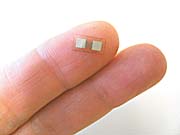
Worldwide RFID spending is expected to total $504 million in 2005, up 39 percent from 2004. RFID will experience broader industry adoption with business value-focused implementations toward the end of 2006 when new license revenue totals $751 million. By 2010, Gartner forecasts worldwide RFID spending to surpass $3 billion.
"Just because bar codes are used extensively in distribution centers does not mean RFID will be," said Jeff Woods, research vice president at Gartner. "Businesses are beginning to discover business value in places where they cannot use bar coding, which will be the force that moves RFID forward."
Gartner analysts said companies should not think of RFID tags as a replacement for bar codes. The two technologies will coexist with users applying the right data collection technology for the right process situation.
"For the most part, bar codes are better at collecting data in highly structured and engineered processes, such as warehouses, and this will likely continue for the next five to seven years," Woods said. "However, RFID tags will be used for data collection of mobile assets and in largely chaotic or unstructured business processes, ranging from retail environments to hospitals, enabling environments that lack sophisticated process engineering or controls to be systematically managed."
According to Woods, companies will need to integrate RFID data into established transactional applications and will need to develop new business applications if they want to put RFID at the center of a process. "In this, the opportunity for real process innovation exists," says Woods.
There is a considerable amount of activity in third-party logistics and shipping companies, but many of the RFID technologies remain immature. RFID has been promoted as a way help secure ports; however Gartner analysts said the technology is not well suited for this role.
For more information, visit www.gartner.com.

